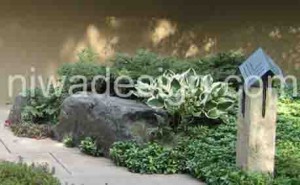Japanese Gardens – Stonework & tenba
 April 23, 2012
April 23, 2012
The use of stones and rocks in Japanese gardens or Zen gardens is an essential element in their design and success; in fact they are the backbone of most Japanese gardens. Quality stonework is essential and achieved through an understanding of how to aesthetically set stones. One by one they are set where the end result is a symphony of stones functioning together as team toward a common aesthetic. I love hand picking specimen stones for specific functions in the garden and working with groups of nondescript stones. When studying a stone and deciding which side to use as the top you should understand the stone with a flat well defined top side is called tenba. Rocks with good tenba do not have to be flashy, or true specimens, in fact most of are not. These somewhat ordinary looking stones with nicely defined flat top sides are typically the strongest element of many stone groupings. The flat top surface is like a level and serves as a horizontal plane which looks clear. You can use these tenba stones to cover the gaps in your garden plantings where you have no scope left for planting other plants or shrubs.
Where they look attractive?
Japanese started this stone setting technique in their gardens and due to the attractive look of stones with good tenba, this feature moved to other parts of the world. You can occupy the blank places in your garden with this rock setting style. Gardens containing rocks with tenba stones are characterized by ultimate beauty and sense of pleasure and sophistication. They are the most amazing thing to observe. There are many of things which we overlook in nature that are made out of stones and rocks.
It would be creative enough to have rocks with tenba in your own backyard garden. You need to establish a mindset for the design and the elements through which you carry out your garden and the use of tenba rocks. You need to select the locations in your garden, the types of stones to use and set the stones in positions that have nice tenba. Â Also keep in mind that good tenba does not mean that the flat upper surface of the stone needs to be perfectly level, it should simply appear to be level. Â In Japanese gardens the stones that have a clearly defined flat top that are not visually level will look sloppy.
You need to make sure whatever plan you come up with is valid and sure. Once you start working on it, evenness and distribution wouldn’t matter either. It is going to give your garden a fake and unnatural look. While applying good tenba you should also be setting your stones in an “in and out†and “up and down†like pattern.
Lastly, remember when you are selecting the stones for your garden to be sure and find some with nice flat surfaces for your tenba stones.
If you would like our help with your Japanese garden project please contact us, Niwa Design Studio, at 952-470-1882.
You can also visit Japanese Garden Journal for more information about Japanese Gardens.

 Posted in
Posted in  content rss
content rss